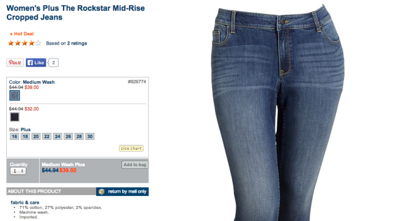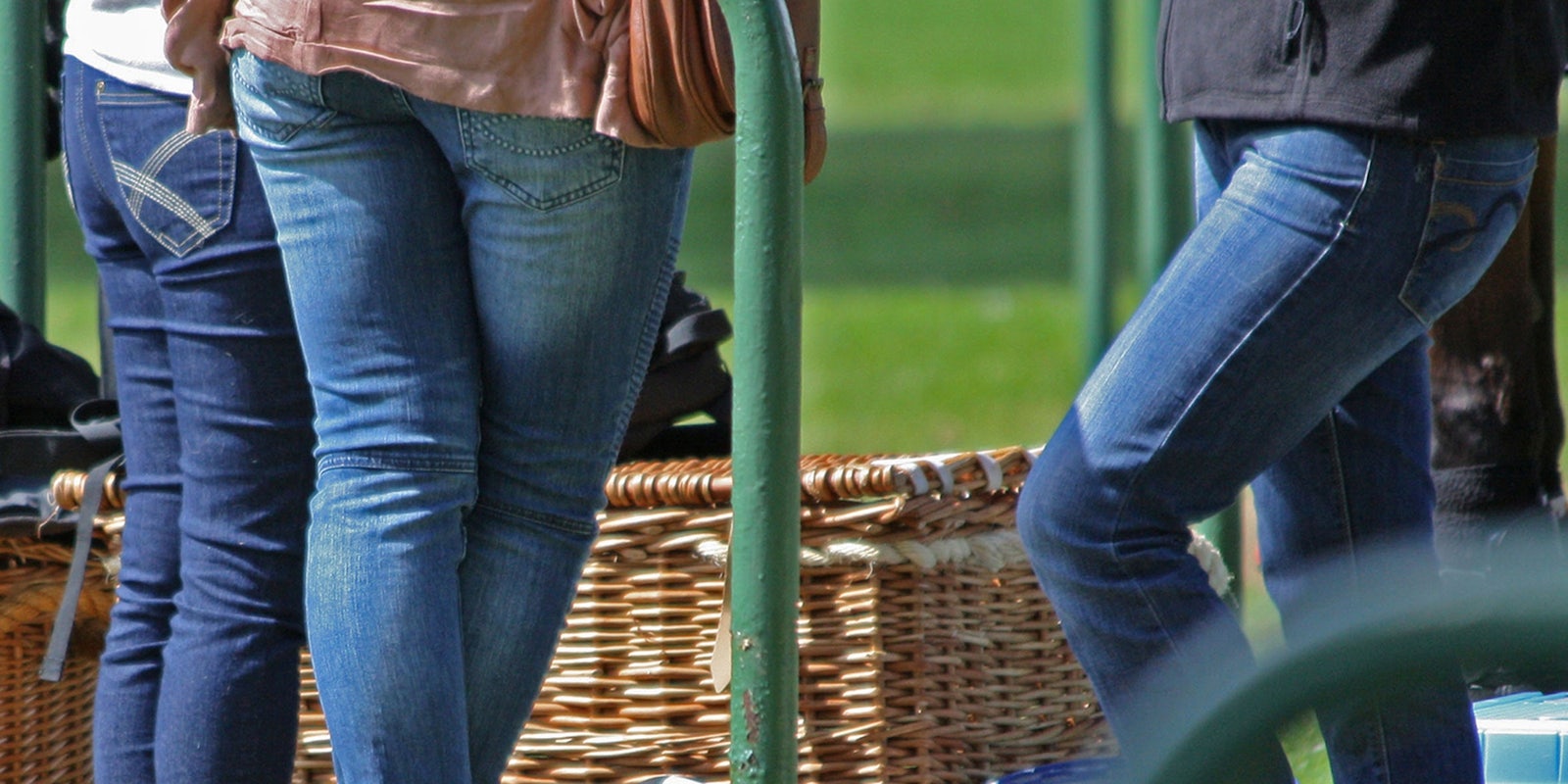BY NIKI FRITZ
Yet another clothing retailer got caught with its pants down—or rather its plus-sized pants on but photoshopped.
In an advertisement for the Old Navy’s Rock Star Jeggings, the retailer added a thigh-gap into its plus-size jeans (because apparently even the big-boned among us must have zero inner leg fat when wearing denim). This little whoopsie-daisy comes a week after Target was called out for using Photoshop to lob off a model’s crotch. Not only did Target slim her thighs but it also took out her labia, giving her the latest trend: Barbie-square lady parts.
Although the Target designers did a particularly heinous job of attempting to create the thigh gap, you know there are 100 other retailers that do a convincing job, so convincing that women everywhere have grown up believing in the thigh-gap myth. This is the idea that a proper woman’s body, in addition to meeting the 36-24-36 standard Sir Mix-a-Lot rapped about, also needs to have a hallowed space in between the upper-most part of the inner leg. According to a 2008 American Psychological Association article, which summarized the findings of 77 different women’s body esteem studies, seeing “thin-ideal bodies” in media creates greater body dissatisfaction among women. The constant barrage of thin models and the thigh gap myth is doing some serious damage to ladies’ leg-esteem.
The thigh gap was definitely alive and rubbing when I was a budding awkward pre-teen. I vividly remember one summer frolicking idyllically through the fields, when I suddenly realized the chaffing happening in my inner thighs where my Soffe shorts had ridden up. I noted the rawness to one of my friends who told me matter-of-factly that my “thighs are not supposed to touch.” Lord knows where she first heard this glimmer of fashion wisdom, but I blame Ally McBeal, with her impossibly skinny and glorified legs.
I spent the next decade or so in pursuit of the thigh gap, but it was soon clear that no amount of dieting would lead me to that coveted half of inch between my thighs or my salvation from the chafe. I was destined to have killer car dance moves, a short temper, a penchant for oversharing,and thighs that touched.
So I started to do the next best thing: protect my precious inner thighs. I tried baby powder, that gel marathoners use so their nipples don’t bleed on mile 17, and extra strength antiperspirant, but still by the end of the day, the rub would get the best of my delicate inner leg skin. It wasn’t until I discovered bike shorts in the blazing summer of 2005 that I found relief from the rub and I learned to live with my lack of gap-age.

Target screengrab via Yahoo News
However, I still feel sometimes that there is something wrong with my chubby inner legs. I wish I could shave off a few inches with a magic Photoshop razor. And I know I’m not alone. I know because I see the way girls stand in their damn Instagram photos, pigeon-toed with hips thrust back, one of the only poses that will make you actually look like you have the elusive thigh gap. Yeah, you look can put a filter on it and say the pose is “hipster-awkward-chic,” but at the end of the day you just look uncomfortable in your body.
Yes, I suppose we could laugh at Photoshop facepalms. These crops are so lazy and horrendous that part of me thinks, wishes, and idealistically hopes that the toucher-upper did the square crotch chop on purpose just to show how ridiculous it is that we are shaving inches off an already thin model. Yet another part of me realizes that it’s just so common that in their rush to get to the next batch, they did a shoddy job and figured no one would notice.
The tragic part is most people wouldn’t. We like to think we are a media-savvy country. We know models are airbrushed and that real people’s bodies don’t look like that, except we don’t and our kids really don’t. A recent 2013 study, showed that while most people won’t let “obvious” skinny models (like Victoria Secret runway models) bring them down, thin models presented in subtle ways (such as modeling swimwear on a major retailer website) do make women feel worse about their bodies. We may be able to understand those Calvin Klein billboards of 10-foot tall waifs are fake, but when we see thin models advertising everything from our shaving cream to our cars to our plus-jeans, how can we help but make that part of our reality and our expectations?
I’m not too concerned about myself. I’ve got my biker shorts and am pumped to enjoy a chafe-free summer. But for pre-teens everywhere who look at the world through magazines and see these magic gap-filled legs, I worry that they won’t be able to enjoy their bodies and their powerful legs for what they can do. When we are presented with such homogenous body images over the course of our lives, we stop being empowered by what our bodies can do and only obsess about what they can’t look like.
Niki Fritz is a writer of feministy and occasionally funny words, a drinker of coffee and whiskey, and a studier of pornography (no legitimately, she’s a grad student in the Telecommunications Department at IU). Check out her musings on porn, academia, and the future of feminism on her blog, feministyfritz.wordpress.com or tweet at her on the Twitter @fritzfrack.
Photo by John Shortland (CC BY 2.0)


